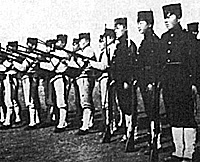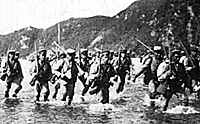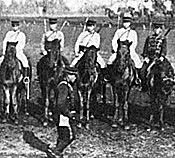JAPANESE INFANTRY
Through this measure and a well-organized system of
depot companies, the Japanese were successful in maintaining the field
strengths of their infantry battalions during the first part of the war.
As the conflict dragged beyond what the war plans anticipated, attrition
took its toll. By the time of the Battle of Mukden, the field strengths
of Japanese battalions had dropped to 600-800 rifles. The problem was that
Japan had reached the limit of the available manpower pool, and was unable
to make up battlefield losses. Along with the drop in field strength was
the decline in quality of the replacements filling the regiments.
The mobilization system provided for the expansion of the army to 800,000 men, but Japan
lacked the training base to sustain the effort. These problems combined to affect battlefield performance of the Japanese army. The inability of the Japanese 3rd Army to complete the encirclement of the Russian forces at Mukden can partially be explained as the result of these inferior replacements. The Russians in 1905 did not face the same foe as they had in 1904.
Two Types of Regiments
The Japanese fielded two types of infantry regiments, the field regiments
and the reserve regiments. The field regiments were manned by active army
soldiers (Genki) and the active, or 1st echelon, reserves (Yobi). The reserve
regiments were manned solely by the 2nd echelon reserves (Kobi). [3]
Two field regiments comprised a brigade, and two brigades formed a division. The active Japanese infantry force consisted of twelve infantry (numbered 1-12) divisions and one guard (Imperial Guards) division. All the regiments in each division were from the same region. A Kobi brigade of two regiments, also regionally recruited, was aligned with each active division. Therefore, when the army mobilized, there were thirteen active divisions, and thirteen Kobi brigades available at the start of the war.
JAPANESE CAVALRY
In the action of Yu-disa-tun, the Russian cavalry decisively out maneuvered and defeated the Japanese 1st Cavalry Brigade. After this action, the Japanese never allowed their cavalry to face the Russian cavalry alone, but placed it in the mountains in the east.
The Japanese employed two different cavalry organizations during the
war. The distinction between the two organizations was based on unit assignment.
Each infantry division was assigned one regiment of cavalry. These regiments
were composed of three cavalry squadrons, each of 200 sabers, and a headquarters
detachment. These divisional cavalry regiments were numbered the same as
their parent division (e.g. 1st Cavalry Regiment was assigned to the 1st
Infantry Division).
The two independent cavalry brigades, the 1st and 2nd Cavalry, possessed two cavalry regiments. Each regiment consisted of four squadrons of 200 sabers apiece and a regimental headquarters detachment. The 1st Cavalry Brigade contained the 13th and 14th Cavalry Regiments;
the 2nd Cavalry Brigade had the 15th and 16th Cavalry Regiments. The Japanese army, lacking a flexible cavalry doctrine, did not develop multiple types of cavalry. The Japanese cavalry was employed as mounted infantry, with fire, rather than shock action, as their primary means of combat.
JAPANESE ARTILLERY
The gun crew was required to relay the gun after each round, reducing the rate of fire. Each infantry division had a regiment of artillery, numbered the same as its parent division. Each regiment had two battalions, composed of three batteries, therefore each division had 36 pieces of artillery assigned. The artillery regiments of the 5th, 8th, 9th, 10th, 11th and 12th Divisions were equipped with mountain batteries. The 7th Division had three batteries of mountain guns, and three of field guns. The remaining divisions were equipped with field guns.
The Japanese also had two field artillery brigades, the 1st and 2nd
Field Artillery Brigades. The Ist Brigade was comprised of 13th, 14th,
and 15th Artillery regiments, and the 2nd had the 16th, 17th, and 18th
regiments. These regiments were organized as the regiments mentioned above,
with six batteries each. All were equipped with the Arisaka field gun.
The third type of artillery was the heavy artillery. The heavy artillery
regiments used a collection of various artillery pieces. The 4.7 inch howitzer
was widely used in the field by the Japanese army. Other pieces used were
either released from home defense, or were captured from the Russians.
The heavy artillery presented a mixed appearance of old and new weapons
on the battlefield. Each battery consisted of four pieces.
The Japanese did not possess horse artillery. The quality and quantity of horses available to Japan made horse artillery a luxury they couldn't afford.
HIGHER ORGANIZATIONS
The Japanese infantry division was a balanced, self-contained formation.
In addition to infantry, cavalry, and artillery regiments, each division
possessed several combat support units. The division had an engineer battalion,
a telegraph company, five ammunition columns, four supply columns, and
six field hospitals. The divisional engineer battalion, numbered as its
parent division, had two engineer companies and a bridge company with 153
yards of bridging material. In all, the Japanese infantry division was
a self-sufficient formation, well suited for independent operations.
During the war, the Japanese did not increase the number of active divisions
in their army. To meet the growing strength of the Russian armies, the
Japanese expanded the Kobi. The Kobi normally were not used to form divisions,
but were used to reinforce the active divisions, or were assigned as separate
brigades within the Japanese armies.
The only exception was the 1st Kobi Division which fought during the Battle of Mukden. The Japanese raised Kobi engineer companies, artillery batteries/detachments, and one cavalry
regiment of three squadrons to support the Kobi infantry units. The Kobi brigades themselves varied in strength from two to five Kobi regiments. The Japanese army did not follow the current European army trends in organizations above the division level. The Japanese did not use a corps structure, but initially formed four armies for the war in Manchuria. A fifth army was
formed prior to the Battle of Mukden. Although called armies, they were, in fact, large army corps. These armies consisted of two to four divisions, several Kobi brigades, additional artillery, and possibly a cavalry brigade. The Japanese Armies displayed great flexibility and hard hitting combat power.
Russo-Japanese War
[2] Cordonnerier, Colonel E.L.V. The Japanese in Manchuria, 1904, Hugh Rees, Ltd., London, 1912. Vol. 1, pg. 23.
This article appears in MagWeb (Magazine Web) on the Internet World Wide Web. The Japanese infantry was organized with four rifle companies and a
headquarters staff in each battalion. Each company was authorized 250 men,
giving a battalion a combat strength of 1,000 rifles. Initially at the
beginning of the war, each company was assigned 300 men in anticipation
of combat losses. [2]
The Japanese infantry was organized with four rifle companies and a
headquarters staff in each battalion. Each company was authorized 250 men,
giving a battalion a combat strength of 1,000 rifles. Initially at the
beginning of the war, each company was assigned 300 men in anticipation
of combat losses. [2]
 The Field regiments deployed three battalions, while the Kobi (reserve) regiments deployed only two battalions. The units in the Japanese army were raised using a system based on the German Krumper model, that of regional recruiting. Each regiment was assigned a recruiting area and based its depot battalion in that region. The depot battalion was responsible for recruiting and training replacements to sustain the field battalions in the theater of war.
The Field regiments deployed three battalions, while the Kobi (reserve) regiments deployed only two battalions. The units in the Japanese army were raised using a system based on the German Krumper model, that of regional recruiting. Each regiment was assigned a recruiting area and based its depot battalion in that region. The depot battalion was responsible for recruiting and training replacements to sustain the field battalions in the theater of war.
 The Japanese cavalry arm during the war suffered from a lack of a strong
military cavalry tradition, a lack of suitable horses, and a lack of natural
horsemanship within the Japanese population. The use of the horse in the
Japanese military prior to the westernization of the army was more akin
to the individual feudal knight than the mass cavalry of post medieval
period. Although endowed with an aggressive spirit and doctrine, the Japanese
cavalry could not match the Russian mounted arm.
The Japanese cavalry arm during the war suffered from a lack of a strong
military cavalry tradition, a lack of suitable horses, and a lack of natural
horsemanship within the Japanese population. The use of the horse in the
Japanese military prior to the westernization of the army was more akin
to the individual feudal knight than the mass cavalry of post medieval
period. Although endowed with an aggressive spirit and doctrine, the Japanese
cavalry could not match the Russian mounted arm.
 The Japanese employed three types of artillery units, field, mountain, and
heavy. The first two, field and mountain batteries, provided the bulk of
the artillery. Each battery consisted of six artillery pieces per battery.
The only difference between the two types was the former was equipped with
the Arisaka field gun, the later with the Arisaka mountain gun. The Arisaka
was a breechloader, but lacked the recoil mechanism of the modern quick-firer.
The Japanese employed three types of artillery units, field, mountain, and
heavy. The first two, field and mountain batteries, provided the bulk of
the artillery. Each battery consisted of six artillery pieces per battery.
The only difference between the two types was the former was equipped with
the Arisaka field gun, the later with the Arisaka mountain gun. The Arisaka
was a breechloader, but lacked the recoil mechanism of the modern quick-firer.
Historical Analysis
The War at a Glance (Chronology)
Books and Other Research Material
Army Organization: Russia
Tactical Doctrine
Uniforms and Standards: Japan
Uniforms and Standards: Russia
Miniature Figures
Footnotes
[3] Cordonnerier, Vol. 1, pgs. 15-16.
[4] Kuropatkin, GEN. A.N., The Russian Army and the Japanese War, E.P. Dutton & Co., 1909, pg. 319.
Back to Table of Contents -- Courier #63
Back to Courier List of Issues
Back to Master Magazine List
© Copyright 1993 by The Courier Publishing Company.
Other military h1story articles and gaming articles are available at http://www.magweb.com